BH6101 Leading Change: A Reflective Essay on Leadership Challenge
VerifiedAdded on 2023/05/28
|9
|1868
|128
Essay
AI Summary
This essay provides a self-reflective analysis of leading a change within a real-life situation, focusing on the implementation of a skill-based training program within an organization to enhance employee performance. The author reflects on their leadership qualities such as delegation, trustworthiness, and positivity, while also acknowledging areas for improvement like patience and talent recruitment. The reflection highlights the importance of self-leadership and servant leadership, culminating in a leadership development plan aimed at enhancing listening skills and building stronger relationships. The essay concludes by emphasizing the role of leadership in providing direction and setting a positive example for staff, with references to relevant leadership theories and practices. Desklib provides this and many other solved assignments for students.
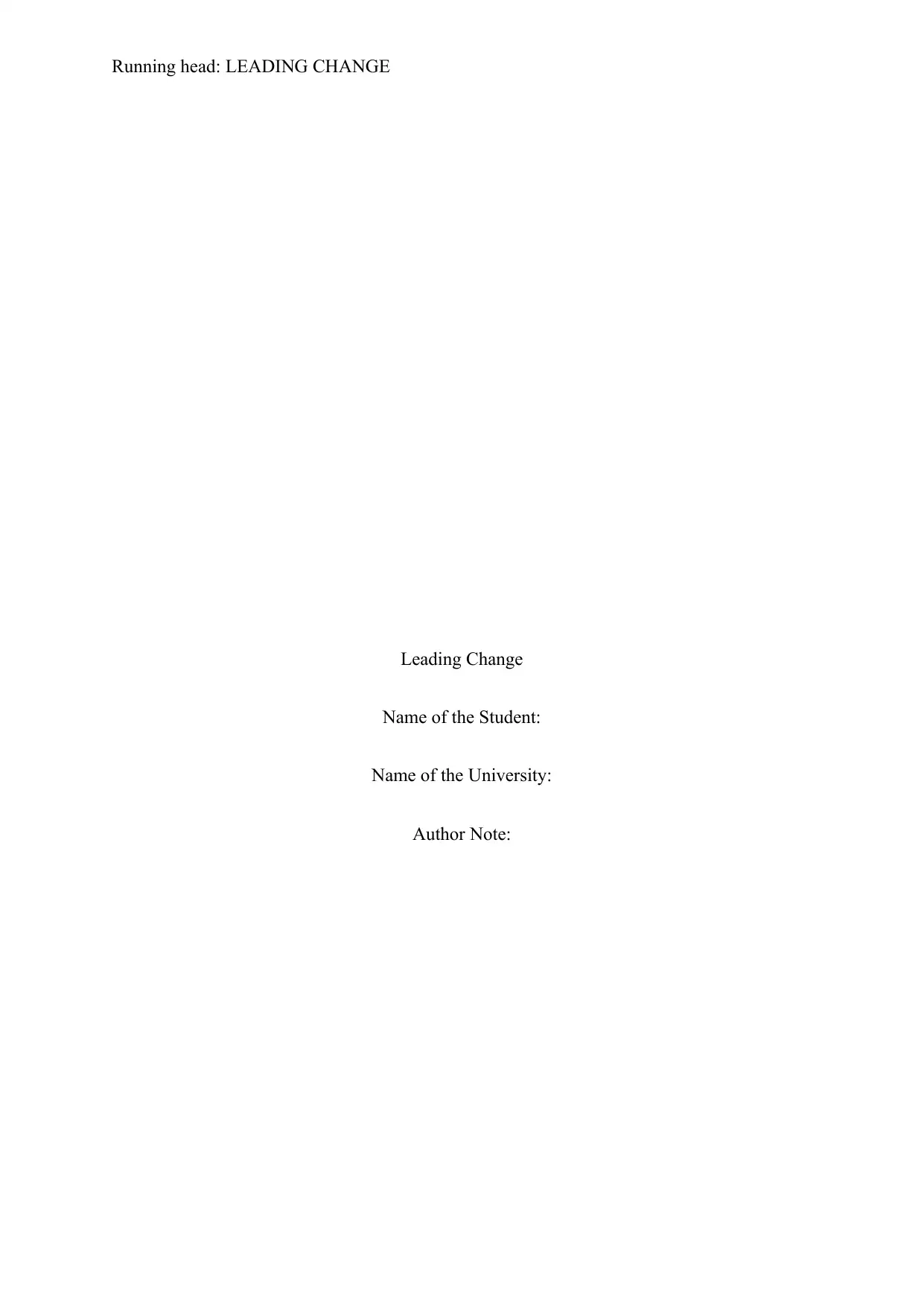
Running head: LEADING CHANGE
Leading Change
Name of the Student:
Name of the University:
Author Note:
Leading Change
Name of the Student:
Name of the University:
Author Note:
Paraphrase This Document
Need a fresh take? Get an instant paraphrase of this document with our AI Paraphraser
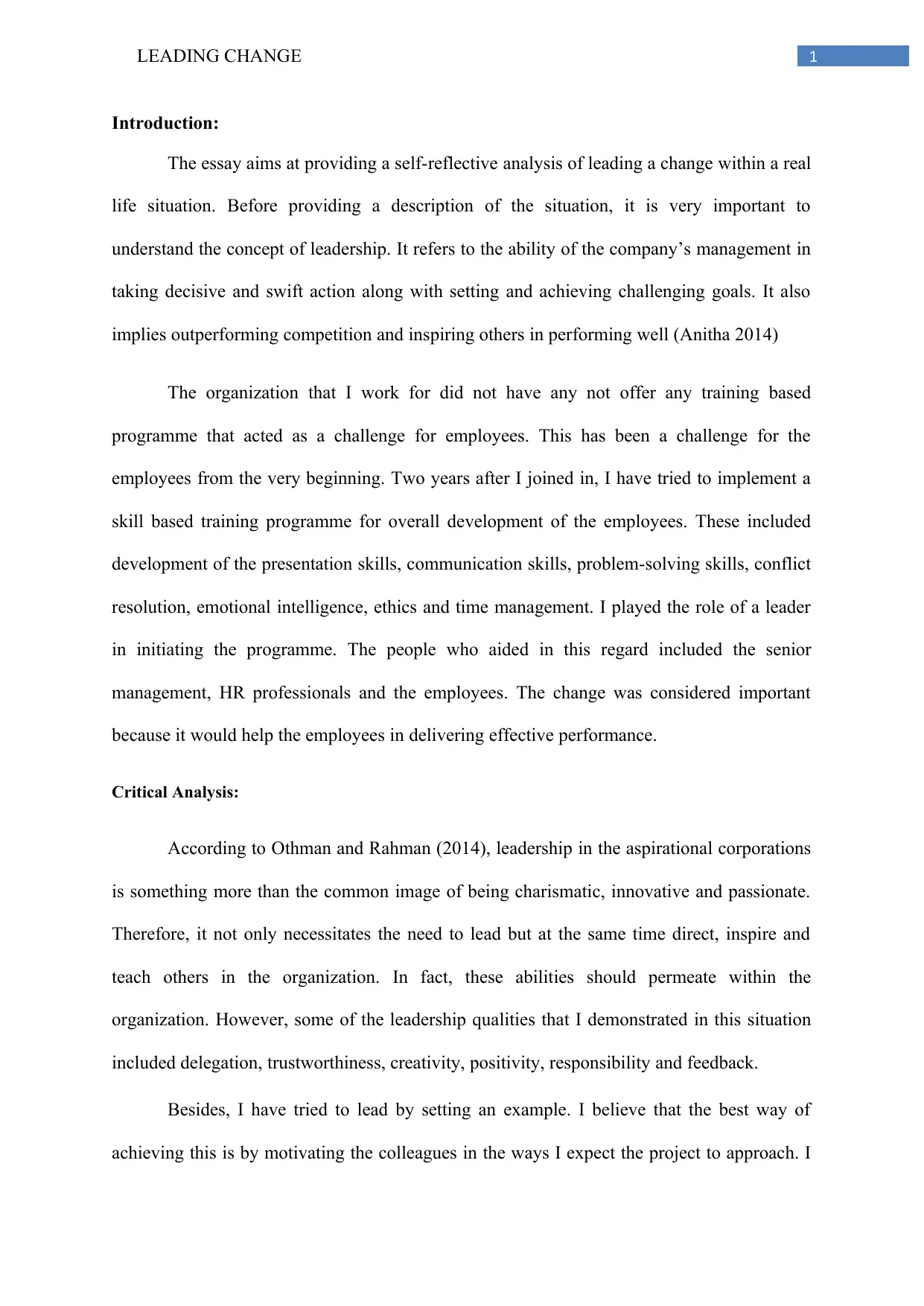
1LEADING CHANGE
Introduction:
The essay aims at providing a self-reflective analysis of leading a change within a real
life situation. Before providing a description of the situation, it is very important to
understand the concept of leadership. It refers to the ability of the company’s management in
taking decisive and swift action along with setting and achieving challenging goals. It also
implies outperforming competition and inspiring others in performing well (Anitha 2014)
The organization that I work for did not have any not offer any training based
programme that acted as a challenge for employees. This has been a challenge for the
employees from the very beginning. Two years after I joined in, I have tried to implement a
skill based training programme for overall development of the employees. These included
development of the presentation skills, communication skills, problem-solving skills, conflict
resolution, emotional intelligence, ethics and time management. I played the role of a leader
in initiating the programme. The people who aided in this regard included the senior
management, HR professionals and the employees. The change was considered important
because it would help the employees in delivering effective performance.
Critical Analysis:
According to Othman and Rahman (2014), leadership in the aspirational corporations
is something more than the common image of being charismatic, innovative and passionate.
Therefore, it not only necessitates the need to lead but at the same time direct, inspire and
teach others in the organization. In fact, these abilities should permeate within the
organization. However, some of the leadership qualities that I demonstrated in this situation
included delegation, trustworthiness, creativity, positivity, responsibility and feedback.
Besides, I have tried to lead by setting an example. I believe that the best way of
achieving this is by motivating the colleagues in the ways I expect the project to approach. I
Introduction:
The essay aims at providing a self-reflective analysis of leading a change within a real
life situation. Before providing a description of the situation, it is very important to
understand the concept of leadership. It refers to the ability of the company’s management in
taking decisive and swift action along with setting and achieving challenging goals. It also
implies outperforming competition and inspiring others in performing well (Anitha 2014)
The organization that I work for did not have any not offer any training based
programme that acted as a challenge for employees. This has been a challenge for the
employees from the very beginning. Two years after I joined in, I have tried to implement a
skill based training programme for overall development of the employees. These included
development of the presentation skills, communication skills, problem-solving skills, conflict
resolution, emotional intelligence, ethics and time management. I played the role of a leader
in initiating the programme. The people who aided in this regard included the senior
management, HR professionals and the employees. The change was considered important
because it would help the employees in delivering effective performance.
Critical Analysis:
According to Othman and Rahman (2014), leadership in the aspirational corporations
is something more than the common image of being charismatic, innovative and passionate.
Therefore, it not only necessitates the need to lead but at the same time direct, inspire and
teach others in the organization. In fact, these abilities should permeate within the
organization. However, some of the leadership qualities that I demonstrated in this situation
included delegation, trustworthiness, creativity, positivity, responsibility and feedback.
Besides, I have tried to lead by setting an example. I believe that the best way of
achieving this is by motivating the colleagues in the ways I expect the project to approach. I
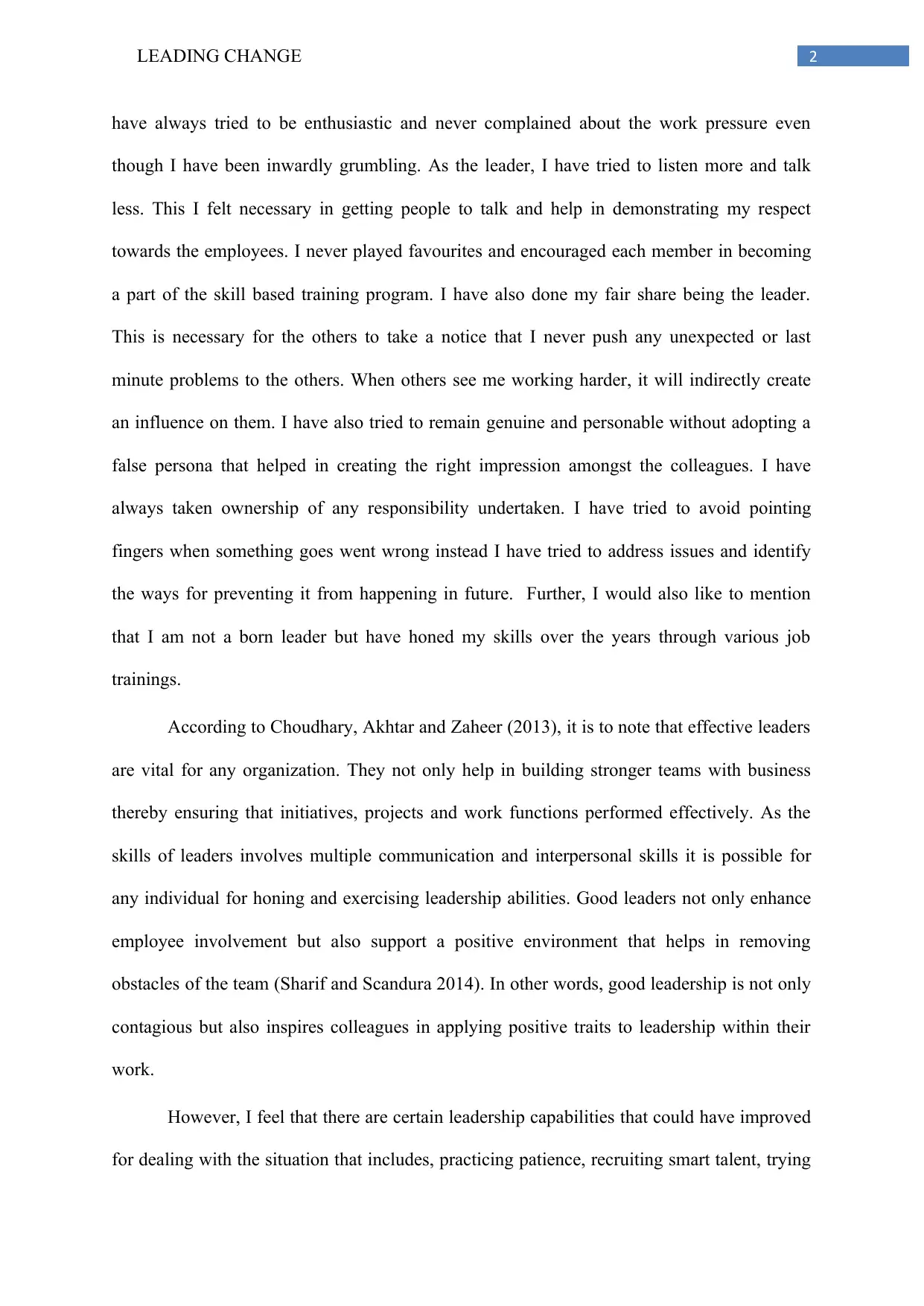
2LEADING CHANGE
have always tried to be enthusiastic and never complained about the work pressure even
though I have been inwardly grumbling. As the leader, I have tried to listen more and talk
less. This I felt necessary in getting people to talk and help in demonstrating my respect
towards the employees. I never played favourites and encouraged each member in becoming
a part of the skill based training program. I have also done my fair share being the leader.
This is necessary for the others to take a notice that I never push any unexpected or last
minute problems to the others. When others see me working harder, it will indirectly create
an influence on them. I have also tried to remain genuine and personable without adopting a
false persona that helped in creating the right impression amongst the colleagues. I have
always taken ownership of any responsibility undertaken. I have tried to avoid pointing
fingers when something goes went wrong instead I have tried to address issues and identify
the ways for preventing it from happening in future. Further, I would also like to mention
that I am not a born leader but have honed my skills over the years through various job
trainings.
According to Choudhary, Akhtar and Zaheer (2013), it is to note that effective leaders
are vital for any organization. They not only help in building stronger teams with business
thereby ensuring that initiatives, projects and work functions performed effectively. As the
skills of leaders involves multiple communication and interpersonal skills it is possible for
any individual for honing and exercising leadership abilities. Good leaders not only enhance
employee involvement but also support a positive environment that helps in removing
obstacles of the team (Sharif and Scandura 2014). In other words, good leadership is not only
contagious but also inspires colleagues in applying positive traits to leadership within their
work.
However, I feel that there are certain leadership capabilities that could have improved
for dealing with the situation that includes, practicing patience, recruiting smart talent, trying
have always tried to be enthusiastic and never complained about the work pressure even
though I have been inwardly grumbling. As the leader, I have tried to listen more and talk
less. This I felt necessary in getting people to talk and help in demonstrating my respect
towards the employees. I never played favourites and encouraged each member in becoming
a part of the skill based training program. I have also done my fair share being the leader.
This is necessary for the others to take a notice that I never push any unexpected or last
minute problems to the others. When others see me working harder, it will indirectly create
an influence on them. I have also tried to remain genuine and personable without adopting a
false persona that helped in creating the right impression amongst the colleagues. I have
always taken ownership of any responsibility undertaken. I have tried to avoid pointing
fingers when something goes went wrong instead I have tried to address issues and identify
the ways for preventing it from happening in future. Further, I would also like to mention
that I am not a born leader but have honed my skills over the years through various job
trainings.
According to Choudhary, Akhtar and Zaheer (2013), it is to note that effective leaders
are vital for any organization. They not only help in building stronger teams with business
thereby ensuring that initiatives, projects and work functions performed effectively. As the
skills of leaders involves multiple communication and interpersonal skills it is possible for
any individual for honing and exercising leadership abilities. Good leaders not only enhance
employee involvement but also support a positive environment that helps in removing
obstacles of the team (Sharif and Scandura 2014). In other words, good leadership is not only
contagious but also inspires colleagues in applying positive traits to leadership within their
work.
However, I feel that there are certain leadership capabilities that could have improved
for dealing with the situation that includes, practicing patience, recruiting smart talent, trying
⊘ This is a preview!⊘
Do you want full access?
Subscribe today to unlock all pages.

Trusted by 1+ million students worldwide
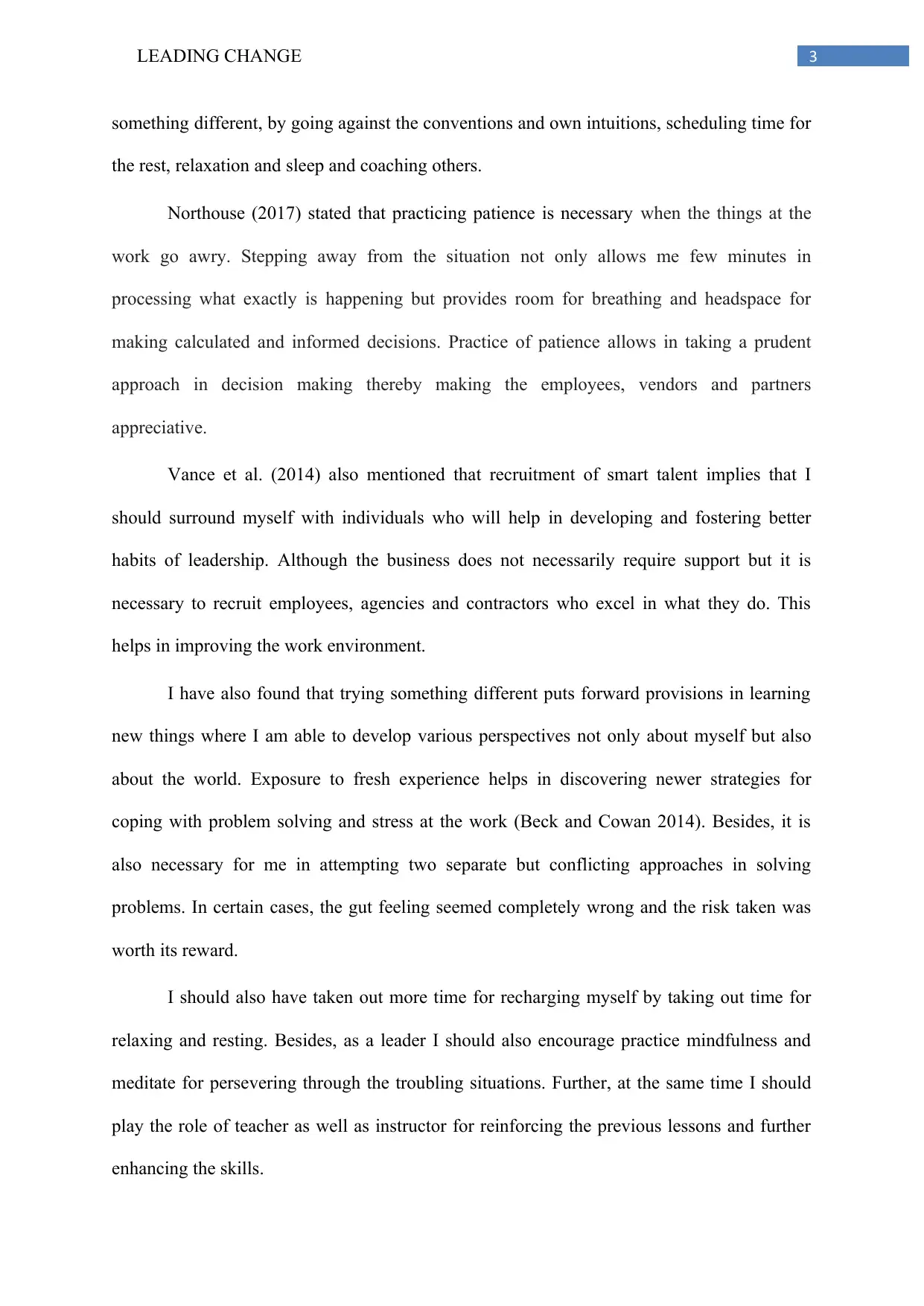
3LEADING CHANGE
something different, by going against the conventions and own intuitions, scheduling time for
the rest, relaxation and sleep and coaching others.
Northouse (2017) stated that practicing patience is necessary when the things at the
work go awry. Stepping away from the situation not only allows me few minutes in
processing what exactly is happening but provides room for breathing and headspace for
making calculated and informed decisions. Practice of patience allows in taking a prudent
approach in decision making thereby making the employees, vendors and partners
appreciative.
Vance et al. (2014) also mentioned that recruitment of smart talent implies that I
should surround myself with individuals who will help in developing and fostering better
habits of leadership. Although the business does not necessarily require support but it is
necessary to recruit employees, agencies and contractors who excel in what they do. This
helps in improving the work environment.
I have also found that trying something different puts forward provisions in learning
new things where I am able to develop various perspectives not only about myself but also
about the world. Exposure to fresh experience helps in discovering newer strategies for
coping with problem solving and stress at the work (Beck and Cowan 2014). Besides, it is
also necessary for me in attempting two separate but conflicting approaches in solving
problems. In certain cases, the gut feeling seemed completely wrong and the risk taken was
worth its reward.
I should also have taken out more time for recharging myself by taking out time for
relaxing and resting. Besides, as a leader I should also encourage practice mindfulness and
meditate for persevering through the troubling situations. Further, at the same time I should
play the role of teacher as well as instructor for reinforcing the previous lessons and further
enhancing the skills.
something different, by going against the conventions and own intuitions, scheduling time for
the rest, relaxation and sleep and coaching others.
Northouse (2017) stated that practicing patience is necessary when the things at the
work go awry. Stepping away from the situation not only allows me few minutes in
processing what exactly is happening but provides room for breathing and headspace for
making calculated and informed decisions. Practice of patience allows in taking a prudent
approach in decision making thereby making the employees, vendors and partners
appreciative.
Vance et al. (2014) also mentioned that recruitment of smart talent implies that I
should surround myself with individuals who will help in developing and fostering better
habits of leadership. Although the business does not necessarily require support but it is
necessary to recruit employees, agencies and contractors who excel in what they do. This
helps in improving the work environment.
I have also found that trying something different puts forward provisions in learning
new things where I am able to develop various perspectives not only about myself but also
about the world. Exposure to fresh experience helps in discovering newer strategies for
coping with problem solving and stress at the work (Beck and Cowan 2014). Besides, it is
also necessary for me in attempting two separate but conflicting approaches in solving
problems. In certain cases, the gut feeling seemed completely wrong and the risk taken was
worth its reward.
I should also have taken out more time for recharging myself by taking out time for
relaxing and resting. Besides, as a leader I should also encourage practice mindfulness and
meditate for persevering through the troubling situations. Further, at the same time I should
play the role of teacher as well as instructor for reinforcing the previous lessons and further
enhancing the skills.
Paraphrase This Document
Need a fresh take? Get an instant paraphrase of this document with our AI Paraphraser
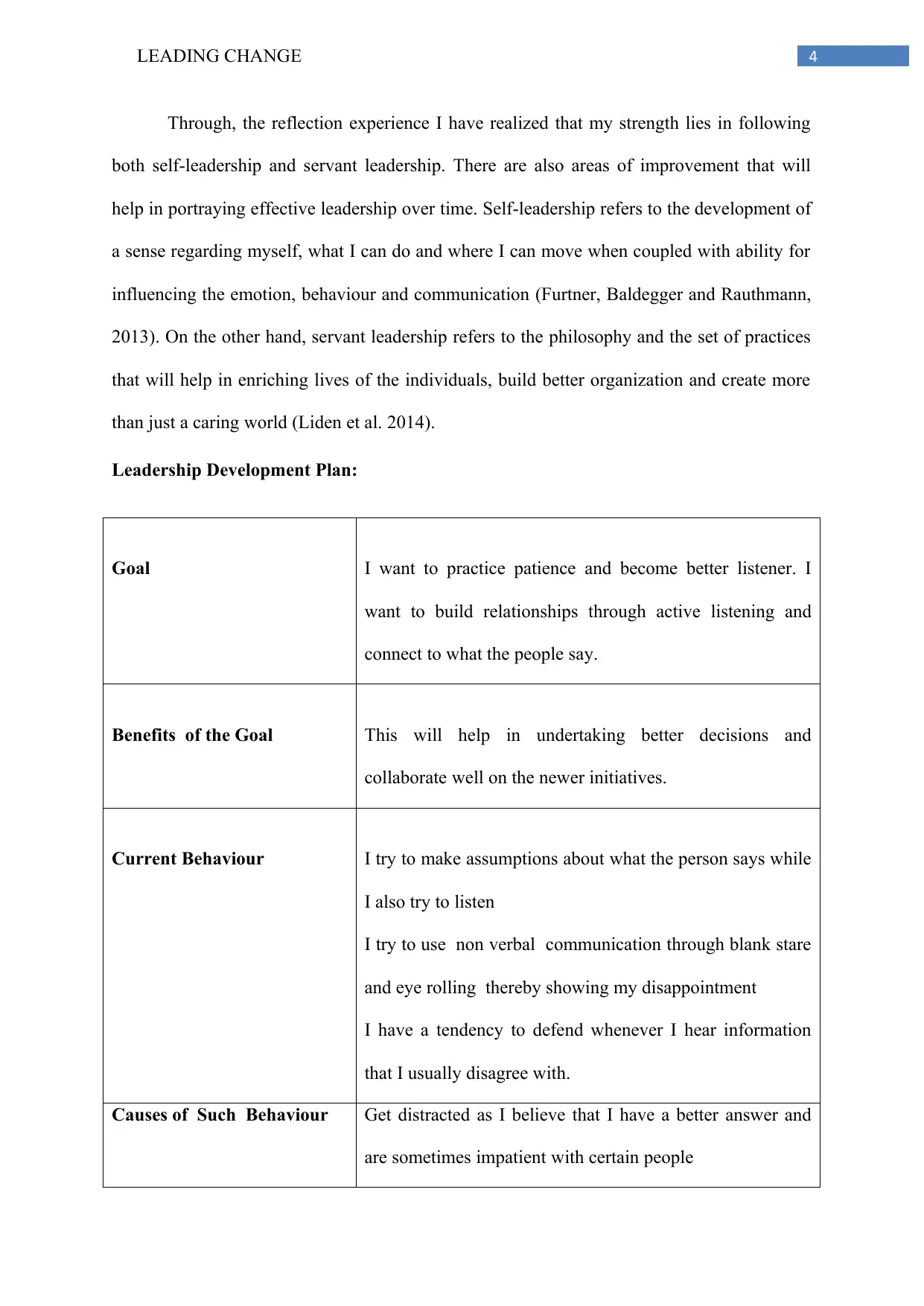
4LEADING CHANGE
Through, the reflection experience I have realized that my strength lies in following
both self-leadership and servant leadership. There are also areas of improvement that will
help in portraying effective leadership over time. Self-leadership refers to the development of
a sense regarding myself, what I can do and where I can move when coupled with ability for
influencing the emotion, behaviour and communication (Furtner, Baldegger and Rauthmann,
2013). On the other hand, servant leadership refers to the philosophy and the set of practices
that will help in enriching lives of the individuals, build better organization and create more
than just a caring world (Liden et al. 2014).
Leadership Development Plan:
Goal I want to practice patience and become better listener. I
want to build relationships through active listening and
connect to what the people say.
Benefits of the Goal This will help in undertaking better decisions and
collaborate well on the newer initiatives.
Current Behaviour I try to make assumptions about what the person says while
I also try to listen
I try to use non verbal communication through blank stare
and eye rolling thereby showing my disappointment
I have a tendency to defend whenever I hear information
that I usually disagree with.
Causes of Such Behaviour Get distracted as I believe that I have a better answer and
are sometimes impatient with certain people
Through, the reflection experience I have realized that my strength lies in following
both self-leadership and servant leadership. There are also areas of improvement that will
help in portraying effective leadership over time. Self-leadership refers to the development of
a sense regarding myself, what I can do and where I can move when coupled with ability for
influencing the emotion, behaviour and communication (Furtner, Baldegger and Rauthmann,
2013). On the other hand, servant leadership refers to the philosophy and the set of practices
that will help in enriching lives of the individuals, build better organization and create more
than just a caring world (Liden et al. 2014).
Leadership Development Plan:
Goal I want to practice patience and become better listener. I
want to build relationships through active listening and
connect to what the people say.
Benefits of the Goal This will help in undertaking better decisions and
collaborate well on the newer initiatives.
Current Behaviour I try to make assumptions about what the person says while
I also try to listen
I try to use non verbal communication through blank stare
and eye rolling thereby showing my disappointment
I have a tendency to defend whenever I hear information
that I usually disagree with.
Causes of Such Behaviour Get distracted as I believe that I have a better answer and
are sometimes impatient with certain people
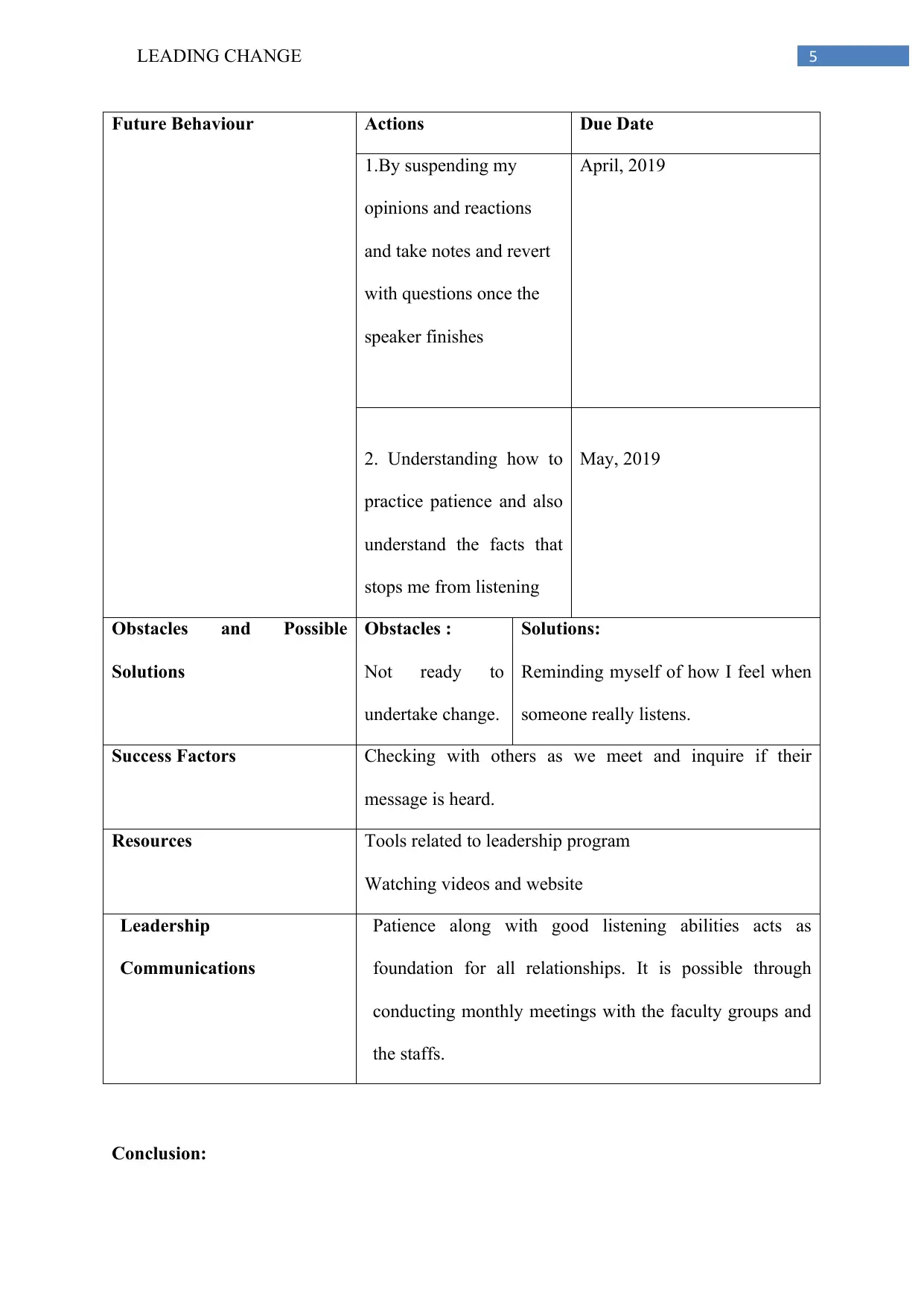
5LEADING CHANGE
Future Behaviour Actions Due Date
1.By suspending my
opinions and reactions
and take notes and revert
with questions once the
speaker finishes
April, 2019
2. Understanding how to
practice patience and also
understand the facts that
stops me from listening
May, 2019
Obstacles and Possible
Solutions
Obstacles :
Not ready to
undertake change.
Solutions:
Reminding myself of how I feel when
someone really listens.
Success Factors Checking with others as we meet and inquire if their
message is heard.
Resources Tools related to leadership program
Watching videos and website
Leadership
Communications
Patience along with good listening abilities acts as
foundation for all relationships. It is possible through
conducting monthly meetings with the faculty groups and
the staffs.
Conclusion:
Future Behaviour Actions Due Date
1.By suspending my
opinions and reactions
and take notes and revert
with questions once the
speaker finishes
April, 2019
2. Understanding how to
practice patience and also
understand the facts that
stops me from listening
May, 2019
Obstacles and Possible
Solutions
Obstacles :
Not ready to
undertake change.
Solutions:
Reminding myself of how I feel when
someone really listens.
Success Factors Checking with others as we meet and inquire if their
message is heard.
Resources Tools related to leadership program
Watching videos and website
Leadership
Communications
Patience along with good listening abilities acts as
foundation for all relationships. It is possible through
conducting monthly meetings with the faculty groups and
the staffs.
Conclusion:
⊘ This is a preview!⊘
Do you want full access?
Subscribe today to unlock all pages.

Trusted by 1+ million students worldwide
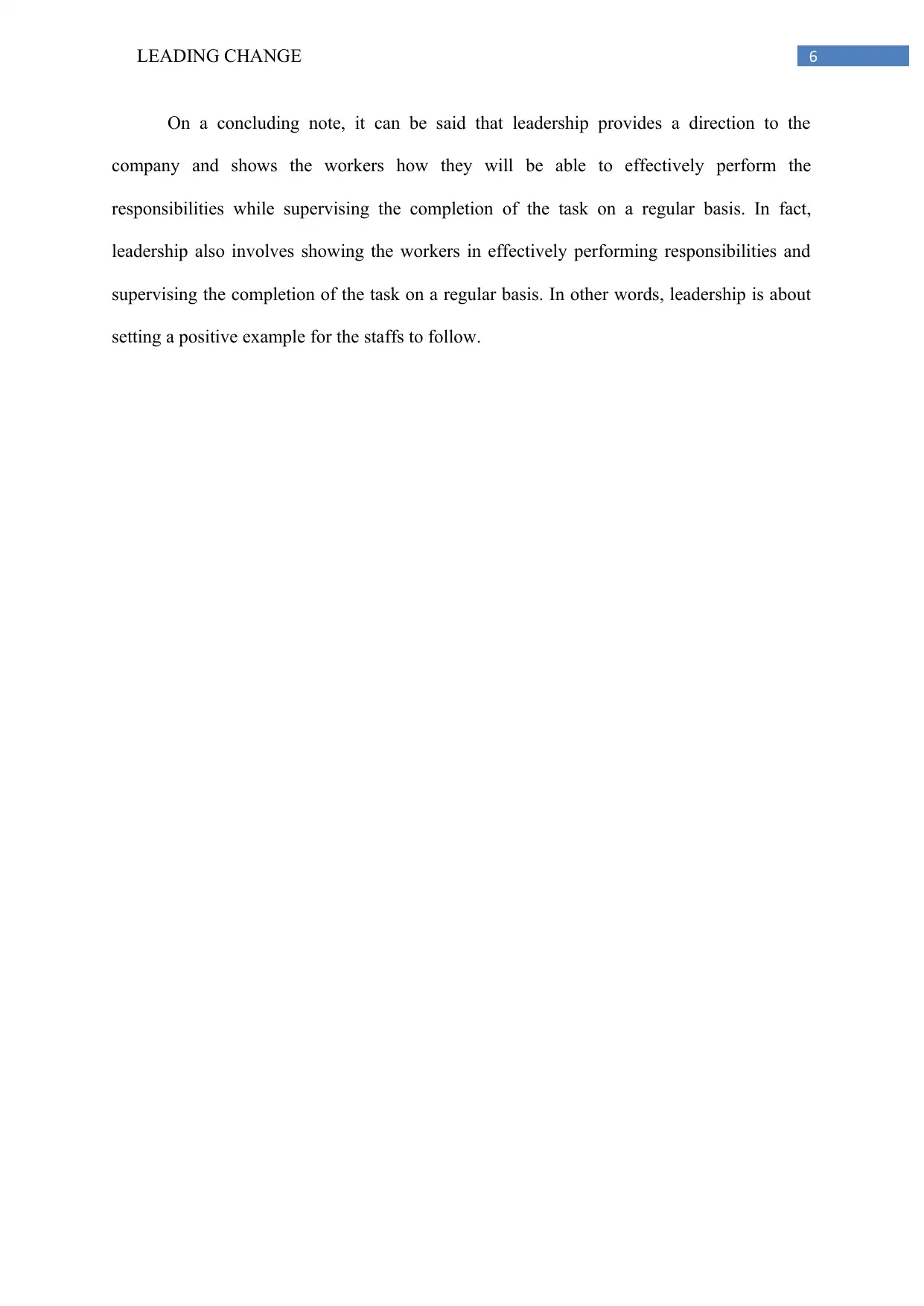
6LEADING CHANGE
On a concluding note, it can be said that leadership provides a direction to the
company and shows the workers how they will be able to effectively perform the
responsibilities while supervising the completion of the task on a regular basis. In fact,
leadership also involves showing the workers in effectively performing responsibilities and
supervising the completion of the task on a regular basis. In other words, leadership is about
setting a positive example for the staffs to follow.
On a concluding note, it can be said that leadership provides a direction to the
company and shows the workers how they will be able to effectively perform the
responsibilities while supervising the completion of the task on a regular basis. In fact,
leadership also involves showing the workers in effectively performing responsibilities and
supervising the completion of the task on a regular basis. In other words, leadership is about
setting a positive example for the staffs to follow.
Paraphrase This Document
Need a fresh take? Get an instant paraphrase of this document with our AI Paraphraser
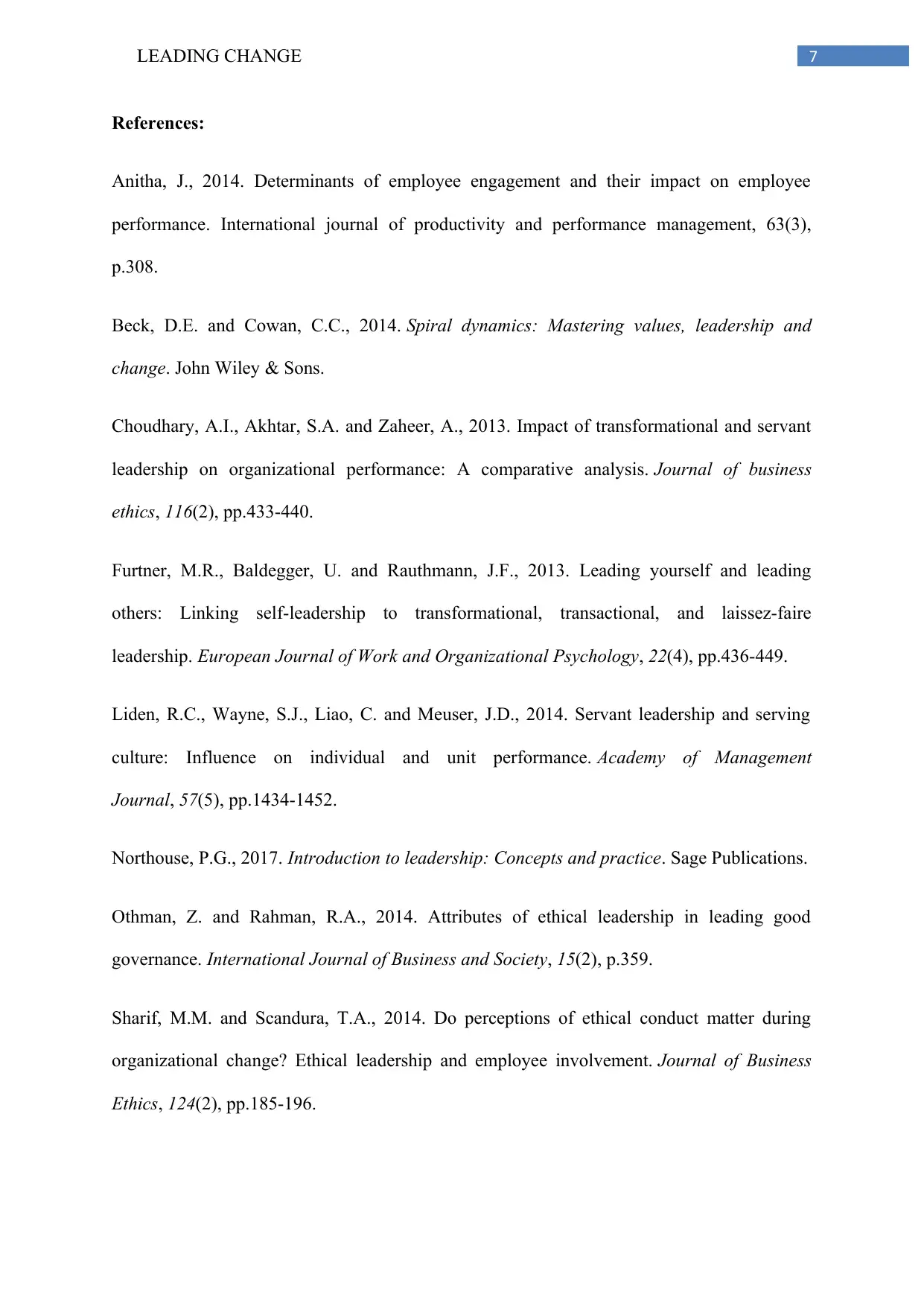
7LEADING CHANGE
References:
Anitha, J., 2014. Determinants of employee engagement and their impact on employee
performance. International journal of productivity and performance management, 63(3),
p.308.
Beck, D.E. and Cowan, C.C., 2014. Spiral dynamics: Mastering values, leadership and
change. John Wiley & Sons.
Choudhary, A.I., Akhtar, S.A. and Zaheer, A., 2013. Impact of transformational and servant
leadership on organizational performance: A comparative analysis. Journal of business
ethics, 116(2), pp.433-440.
Furtner, M.R., Baldegger, U. and Rauthmann, J.F., 2013. Leading yourself and leading
others: Linking self-leadership to transformational, transactional, and laissez-faire
leadership. European Journal of Work and Organizational Psychology, 22(4), pp.436-449.
Liden, R.C., Wayne, S.J., Liao, C. and Meuser, J.D., 2014. Servant leadership and serving
culture: Influence on individual and unit performance. Academy of Management
Journal, 57(5), pp.1434-1452.
Northouse, P.G., 2017. Introduction to leadership: Concepts and practice. Sage Publications.
Othman, Z. and Rahman, R.A., 2014. Attributes of ethical leadership in leading good
governance. International Journal of Business and Society, 15(2), p.359.
Sharif, M.M. and Scandura, T.A., 2014. Do perceptions of ethical conduct matter during
organizational change? Ethical leadership and employee involvement. Journal of Business
Ethics, 124(2), pp.185-196.
References:
Anitha, J., 2014. Determinants of employee engagement and their impact on employee
performance. International journal of productivity and performance management, 63(3),
p.308.
Beck, D.E. and Cowan, C.C., 2014. Spiral dynamics: Mastering values, leadership and
change. John Wiley & Sons.
Choudhary, A.I., Akhtar, S.A. and Zaheer, A., 2013. Impact of transformational and servant
leadership on organizational performance: A comparative analysis. Journal of business
ethics, 116(2), pp.433-440.
Furtner, M.R., Baldegger, U. and Rauthmann, J.F., 2013. Leading yourself and leading
others: Linking self-leadership to transformational, transactional, and laissez-faire
leadership. European Journal of Work and Organizational Psychology, 22(4), pp.436-449.
Liden, R.C., Wayne, S.J., Liao, C. and Meuser, J.D., 2014. Servant leadership and serving
culture: Influence on individual and unit performance. Academy of Management
Journal, 57(5), pp.1434-1452.
Northouse, P.G., 2017. Introduction to leadership: Concepts and practice. Sage Publications.
Othman, Z. and Rahman, R.A., 2014. Attributes of ethical leadership in leading good
governance. International Journal of Business and Society, 15(2), p.359.
Sharif, M.M. and Scandura, T.A., 2014. Do perceptions of ethical conduct matter during
organizational change? Ethical leadership and employee involvement. Journal of Business
Ethics, 124(2), pp.185-196.
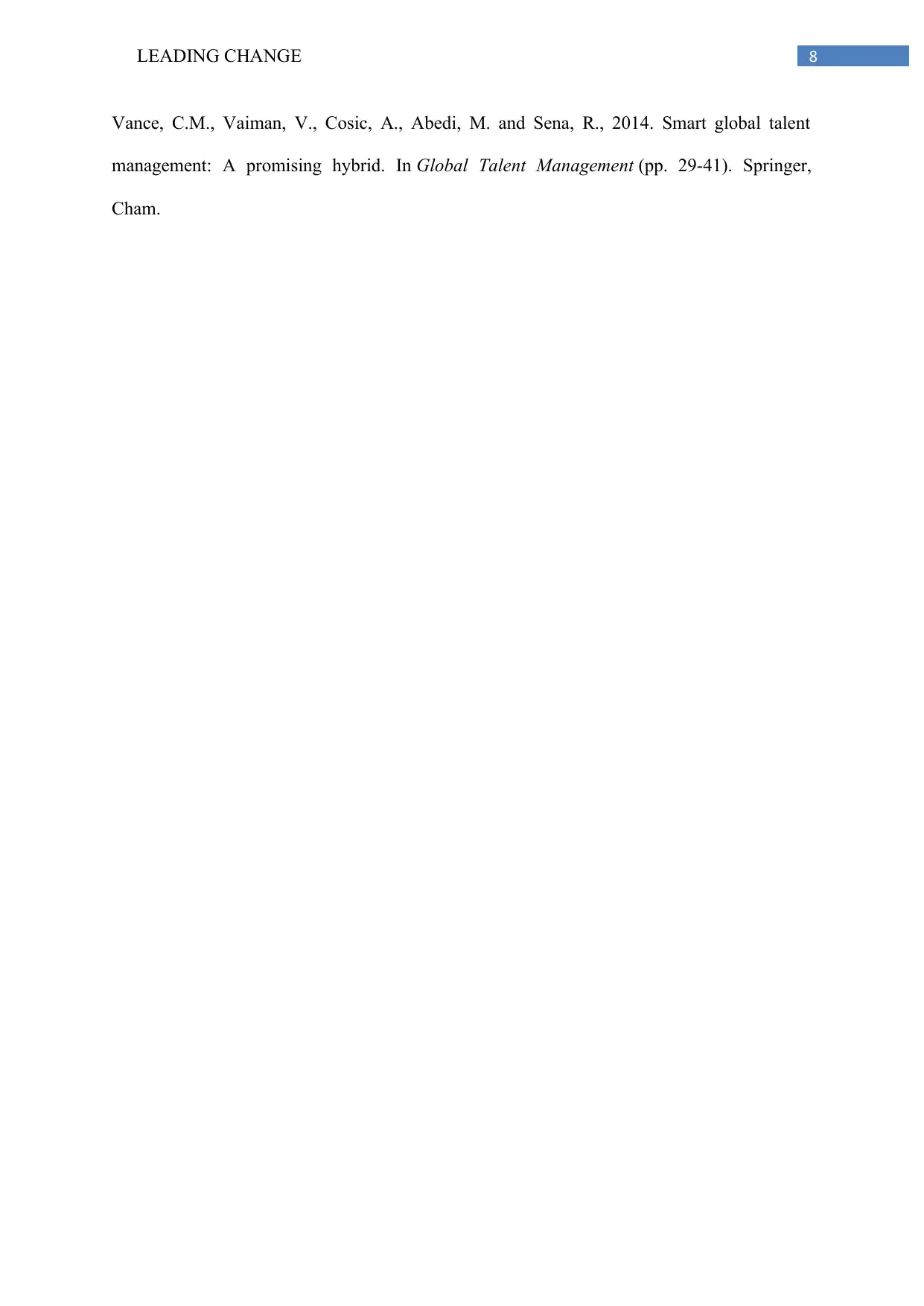
8LEADING CHANGE
Vance, C.M., Vaiman, V., Cosic, A., Abedi, M. and Sena, R., 2014. Smart global talent
management: A promising hybrid. In Global Talent Management (pp. 29-41). Springer,
Cham.
Vance, C.M., Vaiman, V., Cosic, A., Abedi, M. and Sena, R., 2014. Smart global talent
management: A promising hybrid. In Global Talent Management (pp. 29-41). Springer,
Cham.
⊘ This is a preview!⊘
Do you want full access?
Subscribe today to unlock all pages.

Trusted by 1+ million students worldwide
1 out of 9
Related Documents
Your All-in-One AI-Powered Toolkit for Academic Success.
+13062052269
info@desklib.com
Available 24*7 on WhatsApp / Email
![[object Object]](/_next/static/media/star-bottom.7253800d.svg)
Unlock your academic potential
Copyright © 2020–2025 A2Z Services. All Rights Reserved. Developed and managed by ZUCOL.



